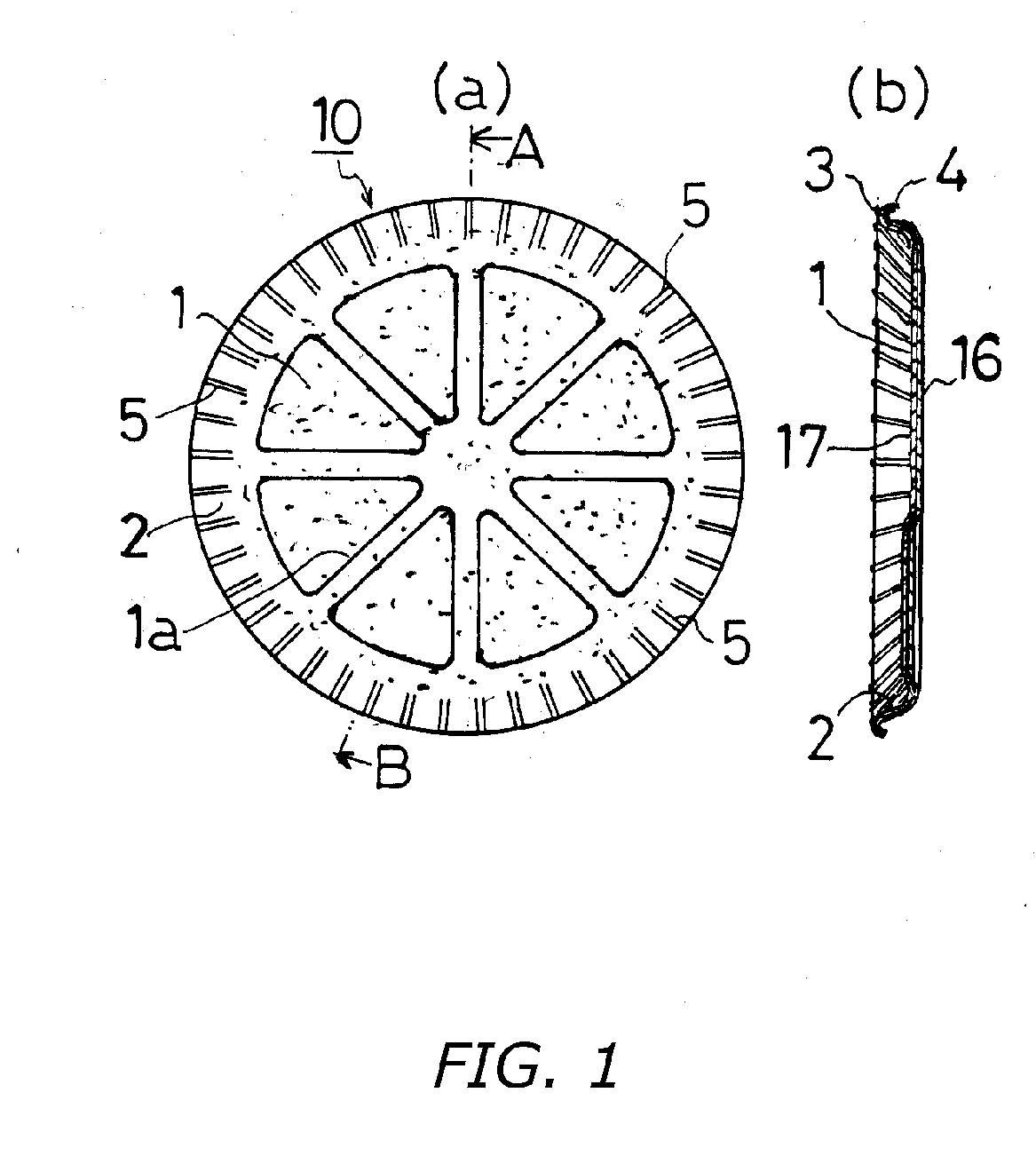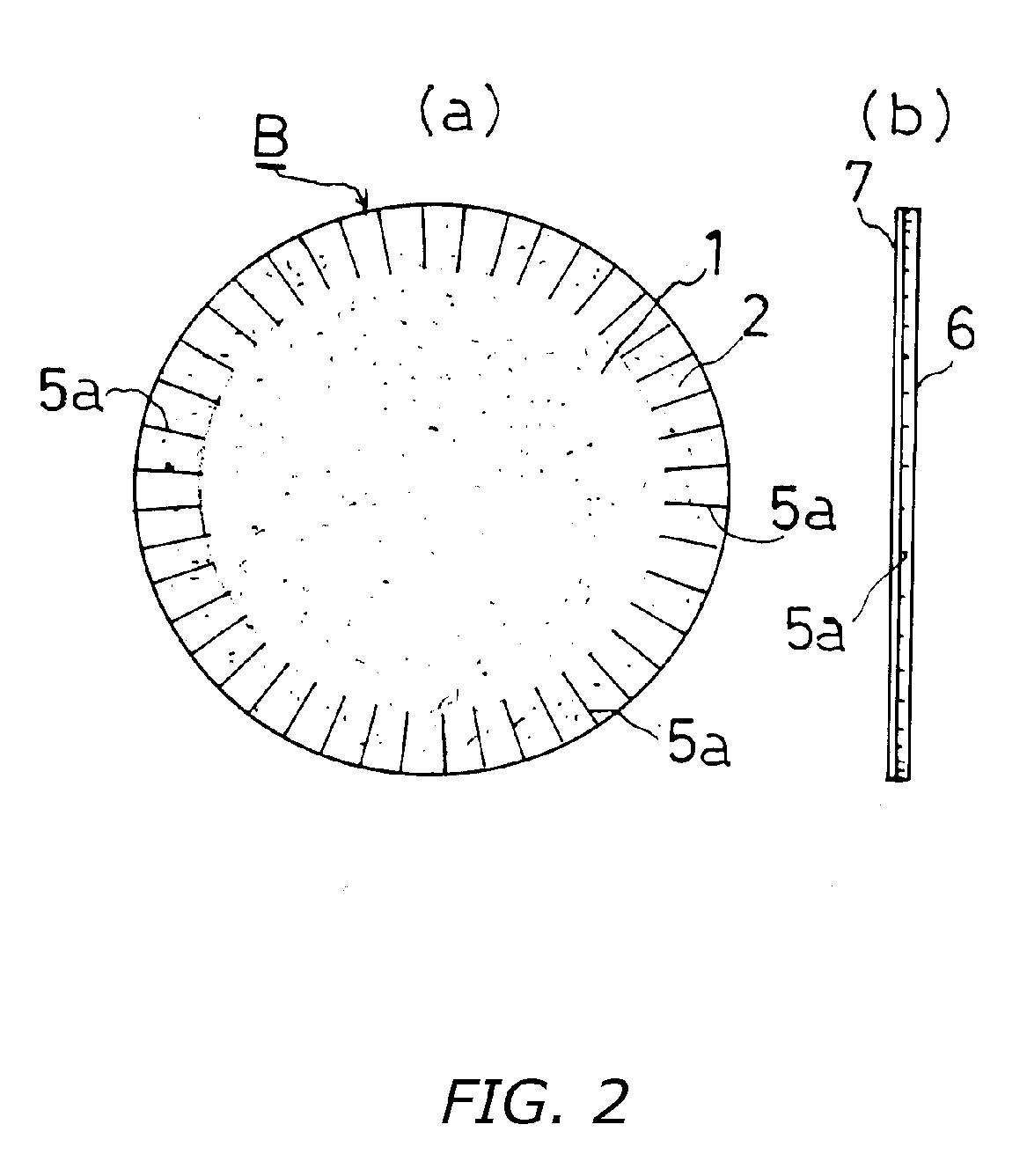Disposable Paper Eating Utensils for Catering Service
a paper-made, food technology, applied in the field of paper-made food disposal utensils, can solve the problems of limited contamination caused by dished up foods, and achieve the effect of reducing production costs and preventing shifting
- Summary
- Abstract
- Description
- Claims
- Application Information
AI Technical Summary
Benefits of technology
Problems solved by technology
Method used
Image
Examples
working example 1
[0041] The above is an overview of the working example 1 of the paper vessel according to the invention that is shown in FIGS. 1 and 2. The working example 1 is described in further detail below. In the circular plate 10, the blank 6 is cut from the thick paper taking into account the diameter corresponding to the bottom portion 1, the height of the rising side-wall portion 2, the edge portion 3, the extra rim 4, and also such that it is provided with the necessary area for trimming. Further, the wrinkle guide lines 5a (also referred to as folding markings) that centripetally converge from the circumferential portion of the blank 6 up to the rising side-wall portion 2 and the position in vicinity of the bottom periphery of the vessel are precut into the upper side of the blank 6.
[0042] The act of heating the metal mold 20 (see FIG. 3) to about 160° C., furnishing it with the blank B that is obtained by laminating the thin-paper blank 7 on the thick-paper blank 6 of FIG. 2, both of ...
working example 2
[0044] Working Example 2, wherein the vessel is referred to as a “tray,” is described with reference to FIGS. 5 to 7. FIG. 5 shows the blank 6, which is made of thick paper for molding an oblong tray 110 (see FIG. 6) in which angled ribs are formed in the bottom surface. Centripetally converged wrinkle guide lines 5a are provided in the four corners, and parallel wrinkle guide lines 5a are provided in substantially the center portions of the four sides of this oblong blank 6 from the edge of the blank to positions R that substantially correspond to the slanted surface 2 and the outer periphery of the vessel bottom surface. Also, cross-shaped ribs 9a are provided in a cross shape in the bottom surface 1 of the vessel. A single sheet or a plurality of sheets of a blank 7 (see FIG. 6) made of thin paper whose shape is substantially identical to that of the blank 6 (the folding lines are not necessary) is / are layered onto the blank 6, forming the blank B (not shown). It should be noted ...
working example 3
[0046] Working Example 3 is described with reference to FIGS. 8 to 10. In the paper vessel 111 shown in FIG. 8, a tray unit 30 and a lid member 31 that can open and close are connected through a hinge 8 and molded as one piece. Viewing windows 6w that are provided as openings in the lid member 31 are closed off by the upper vessel made of thin paper in such a manner that they can be seen through. As shown in FIG. 9, the blank B for molding this vessel is partitioned into a lid member side 8b and a main unit side 8c by forming notches 8a in both ends in substantially the center portion of two opposing edges of the thick paper 6 and the thin paper 7, that is, the portion where the hinge 8 is to be formed. The thick paper blank 6 is further provided with wrinkle guide lines 5a in the four corners of its lid member side and its main unit side, and if necessary, a rib guide line 9a for forming an angled rib (see FIG. 8), for example, is provided in the surface corresponding to the bottom...
PUM
| Property | Measurement | Unit |
|---|---|---|
| durability | aaaaa | aaaaa |
| shape | aaaaa | aaaaa |
| dimensions | aaaaa | aaaaa |
Abstract
Description
Claims
Application Information
 Login to View More
Login to View More - R&D
- Intellectual Property
- Life Sciences
- Materials
- Tech Scout
- Unparalleled Data Quality
- Higher Quality Content
- 60% Fewer Hallucinations
Browse by: Latest US Patents, China's latest patents, Technical Efficacy Thesaurus, Application Domain, Technology Topic, Popular Technical Reports.
© 2025 PatSnap. All rights reserved.Legal|Privacy policy|Modern Slavery Act Transparency Statement|Sitemap|About US| Contact US: help@patsnap.com



